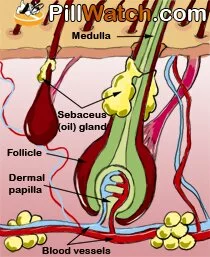
Hair was given to the mammals bodies to protect them from heat and cold, wind and sunlight. In animals this function still remains, but human hair has practically lost it in the course of evolution.
Nevertheless, these days people pay much attention to the state of their hair. Nowadays this element of our bodies has pure esthetic function. However, the latter should not be underestimated: millions of men and women suffer psychologically very much if their hair is in the bad state; both sexes are equally terrified by the word baldness.
Logically, to be able to take good care and preserve hair beauty, we should know what it actually is and how it grows.
To start with, one should realize that hair is made of dead protein cells, called keratin. Protein, being digested in the body, forms different amino acids. The latter can be connected in the particular combinations, producing different forms of protein in our organisms: keratin, collagen, insulin, etc. The first one is the source of our hair.
The very first hair a human being acquires is called lanugo. It appears on the skin surface during the intrauterine development of a baby. Lanugo is silky, glossy, and almost invisible, since it has no pigment.
Besides lanugo there are three more types of the human hair: - vellus hair, which is soft, fine, short, and non-pigmented; - terminal hair is pigmented and quite long; male arms, chest, and legs hairs are terminal, as well as hairs on the scalp; - intermediate it is something in between the first two types; it is usually moderately pigmented.
The structure of the hair is not difficult to understand. First of all, it has two main parts: the hair shaft (the actual hair we can see on the skin surface) and the hair follicle (the point from which hair grows).
A cup-shaped hair follicle is located in the fat of the skin. Its lower part is called the hair bulb, a place, where hair cells are formed. The newly produced cells push the older ones out of the bulb. On their way out they are slightly changed; some of them will form the lining of the follicle, the others will become the actual hair.
A hair bulb contains the nutritious elements, oxygen, and amino acids necessary for hair growth, as well as pigment melanin (either eumelanin, which makes hair black or brown, or pheomelanin, making it red or blond).
In the mid-follicle region all the cells pushed out of the bulb die and harden. They still continue to move out of the follicle, and beyond its boundaries they are known as hair shaft.

The hair shaft consists of the inner part (cortex), which contains small amounts of water, vitamins, fats, pigment, and the traces of different metals. Cortex is covered by a protective layer - cuticle. If the latter is smooth, glossy, and undamaged, hair looks beautiful. In the other case it loses its shine and smoothness.
Just like the plants, which have periods of active growth and time to rest, our hair has the anagen phase, when new hair cells are constantly produced (2-6 years), the catagen phase, when hair stops growing and prepares to have some rest (1-2 weeks), and the telogen phase resting time itself, during which all fully grown hairs are shed (5-6 weeks). Then everything starts all over again.
Now, its high time for us to have some rest and, perhaps, a bit of meditation over the information gained to fully understand and remember it.
Ivanna
| Tip for you : Sign-in with Your OpenID and post faster, easier and with easy access to all your past posts. | |
|
Your Nick: |
















